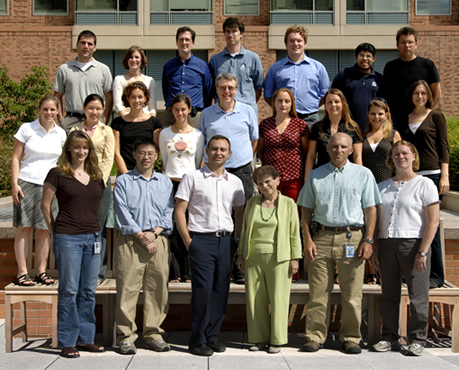|
|
 |
Back to Previous Page Previous Page
Cognitive Neuroscience Section

Jordan Grafman, Ph.D., Senior Investigator
Dr. Grafman received his B.A. degree from Sonoma State University in California and his Ph.D. from the University of Wisconsin-Madison in 1981. Immediately following his graduation, Dr. Grafman became the Neuropsychology Chief on the Vietnam Head Injury Study, a multidisciplinary study conducted at Walter Reed Army Medical Center in Washington, D.C. In 1986, he joined the NINDS as a Senior Staff Fellow in the Clinical Neuropsychology Section. In 1989, Dr. Grafman became Chief of the Cognitive Neuroscience Section in the NINDS. He is an elected fellow of the American Psychological Association and has received both the Defense Meritorious Service Award and the National Institutes of Health Award of Merit. Dr. Grafman's Section is attempting to identify the nature of representational knowledge stored in the human prefrontal cortex, the cognitive properties of representational binding that form episodes in memory, and the types of cognitive neuroplasticity that occur during learning and recovery from brain damage.
 |  |
Staff:

- Aron Barbey, Ph.D., Postdoctoral Fellow, 301-402-6392 barbeya@ninds.nih.gov
- Sandra Bonifant, B.S., Program Coordinator, 301-594-5751 bonifans@ninds.nih.gov
- Karen DeTucci, M.A., Research Associate detuccik@ninds.nih.gov
- Kris Knutson, M.A., Research Assistant, 301-402-6920 knutsonk@ninds.nih.gov
- Frank Krueger, Ph.D., Research Fellow, 301-435-1583 krugerf@ninds.nih.gov
- Anne Leopold, B.A., Research Associate leopolda@ninds.nih.gov
- Carolee Noury, M.A., Research Assistant nouryc@ninds.nih.gov
- Dan Ruchkin, Ph.D., Adjunct Investigator, 301-402-6395 ruchkind@ninds.nih.gov
- Andres Salazar, M.D., Adjunct Investigator, 301-496-0220 ASalazar@ribopharm.com
- Michael Tierney, M.A., Patient Coordinator, 301-496-0221 tierneym@ninds.nih.gov
- Justin Vassar, B.A., Research Assistant vassarj@ninds.nih.gov
Research Interests:
The major goal of the Cognitive Neuroscience Section is to characterize the forms of knowledge represented in the human prefrontal cortex. While it is believed that the prefrontal cortex plays a crucial role in planning, social cognition, reasoning, and reflection, scientists remain puzzled about its underlying cognitive architecture and the number of circumscribed prefrontal cortex brain sectors subserving specific cognitive operations and/or knowledge. We have developed a framework that specifies some of the characteristics of the prefrontal cortex's cognitive architecture. We have termed the bound memory units stored in the prefrontal cortex the structured event knowledge complex . Numerous ongoing studies in the Section are dedicated to testing hypotheses generated by the framework we have adapted.
A second goal of the Section has been to identify the forms of neuroplasticity in the human brain from the perspective of cognitive neuropsychology. In an effort to understand some of the neuroplastic properties of local circumscribed brain sectors, we have been examining how brain sector topography changes in response to normal skill learning. We have also attempted to understand how local circumscribed brain sectors may have their maps altered by brain damage in children and adults via homologous region adaptation of function. Finally, we are attempting to ascertain how induced restrictions in processing stimuli via a particular sensory modality leads to cross-modal plasticity.
A third goal of the Section has been to better understand the types of information binding that occur in the human brain. To achieve these three goals, the Section utilizes cognitive science methods with MRI, fMRI, PET, and other imaging techniques. In addition, the NINDS Brain Stimulation Unit (Eric Wassermann, Chief) is integrated with the Cognitive Neuroscience Section and pursues studies in the neurophysiology of frontal lobe and executive function and develops techniques for probing and modulating cognitive functions such as transcranial magnetic and direct current stimulation. Dr. Wassermann also directs the Neurological activities of the Cognitive Neuroscience Section.
 |  |
Clinical Protocols:
- Testing A Model of the Representational Knowledge Stored in the Human Prefrontal Cortex 02-N-0001
- Functional Neuroimaging of Calculus Problem Solving 03-N-0178
- Functional Neuroimaging of Social Cognitive and Emotional Processing: Technical and Cognitive Issues 03-N-0195
- Regional Cerebral Utilization of Glucose in Patients with a Diagnosis of Frontal Lobe Dementia, Atypical Parkinsonian Disorder, and Other Basal Ganglia Disorders 81-N-0010
- Social Knowledge Representation in the Human Prefrontal Cortex 03-N-0196
- Reasoning About Social and Economic Knowledge: Identifying the Role of the Human Prefrontal Cortex Using Functional Neuroimaging 03-N-0197
Selected Publications:
- Krueger, F., McCabe, K., Moll, J., Kriegeskorte, N., Zahn, R., Strenziok, M., Heinecke, A., and Grafman, J. (2007) The Neural Correlates of Trust, Proceedings of the National Academy of Sciences 104 (50), 20084-20089. Full Text/Abstract
- Krueger, F., Moll, J., Zahn, R., Heinecke, A., and Grafman, J. (2007) Event Frequency Modulates the Processing of Daily Life Activities in Human Medial Prefrontal Cortex, Cerebral Cortex 17, 2346-2353. Full Text/Abstract
- Zahn, R., Moll, J., Krueger, F., Huey, E.D., Garrido, G., and Grafman, J. (2007) Social Concepts are Represented in the Superior Anterior Temporal Cortex, Proceedings of the National Academy of Sciences 104 (15), 6430-6435. Full Text/Abstract
- Knutson, K.M., Mah, L., Manly, C.F., and Grafman, J. (2007) Neural Correlates of Automatic Beliefs about Gender and Race, Human Brain Mapping 28 (10), 915-930. Full Text/Abstract
- Moll, J., Krueger, F., Zahn, R., Pardini, M., de Oliveira-Souza, R., and Grafman, J. (2006) Human Fronto-mesolimbic Networks Guide Decisions about Charitable Donation., Proceedings of the National Academy of Sciences 103 (42), 15623-15628. Full Text/Abstract
- Moll, J., Zahn, R., de Oliveira-Souza, R., Krueger, F., and Grafman, J. (2005) The neural basis of human moral cognition, Nature Reviews Neuroscience 6 (10), 799-809. Full Text/Abstract
- Wood, J.N. and Grafman, J. (2003) Human Prefrontal Cortex: processing and representational perspectives, Nature Reviews Neuroscience 4 (2), 139-147. Full Text/Abstract
All Selected Publications
Contact Information:
Dr. Jordan Grafman
Chief, Cognitive Neuroscience Section
National Institute of Neurological Disorders and Stroke
Building 10; Room 7D43
MSC 1440
Bethesda, MD 20892-1440
Telephone: 301-496-0220 office,
301-496-0220 laboratory,
301-480-2909 fax
Email: grafmanj@ninds.nih.gov
|

